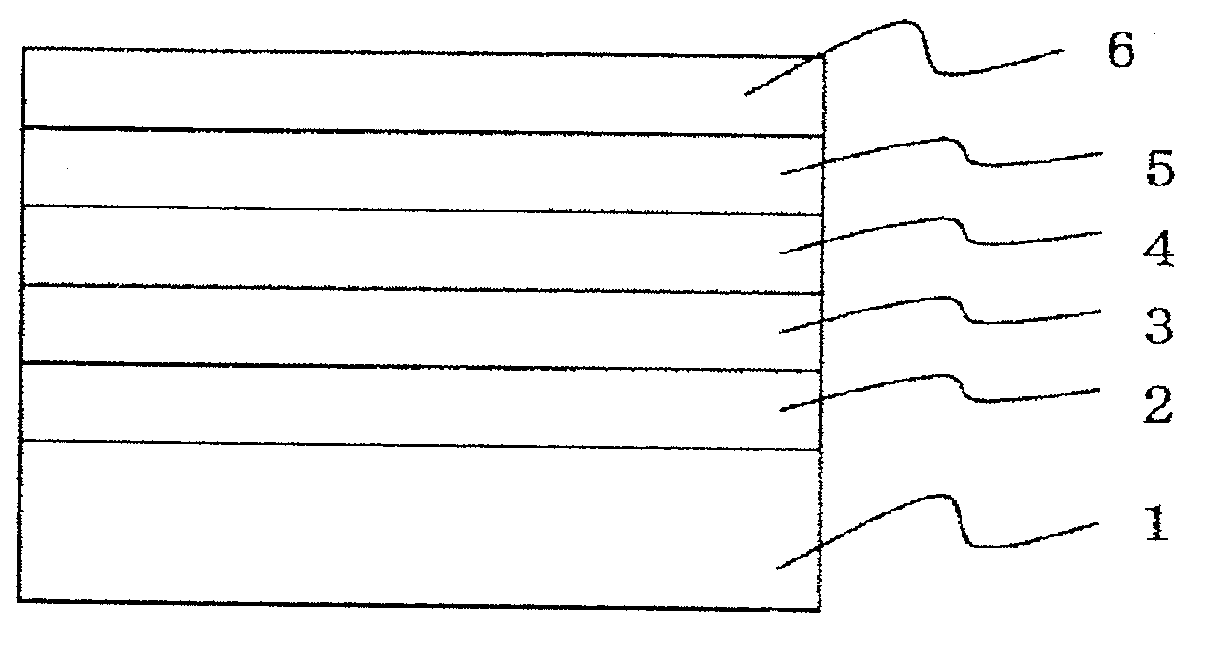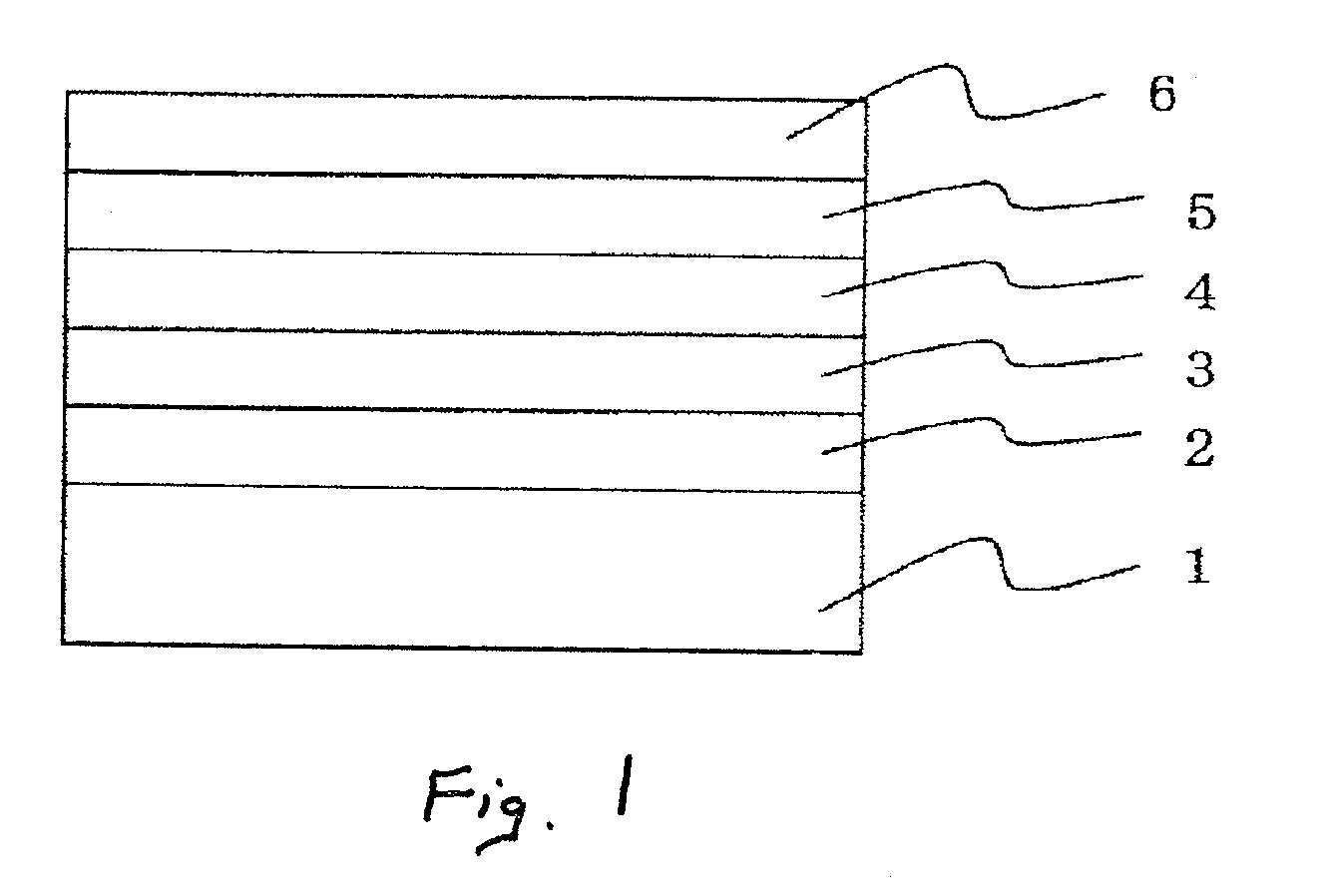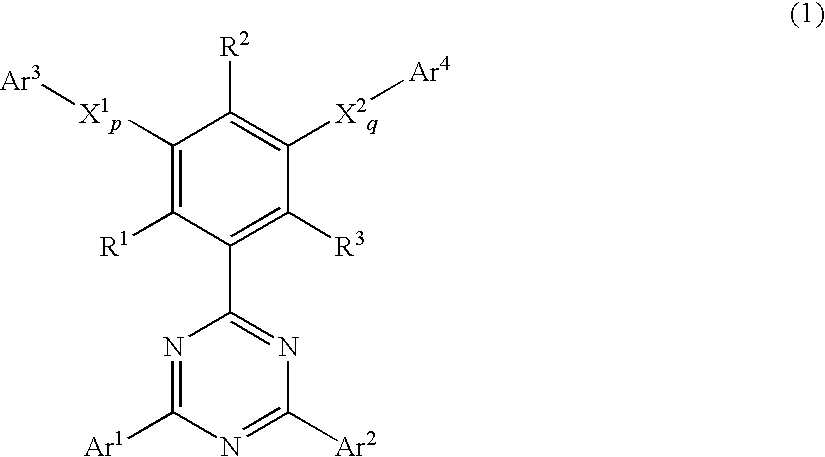Phenyl-substituted 1,3.5-triazine compound, process for producing the same, and organic electroluminescent device containing the same as component
a technology of triazine and compound, which is applied in the field of phenylsubstituted 1, 3, 5triazine compound and a process for producing the compound, can solve the problems of low production cost, many technical problems to be solved, and small power consumption, and achieve the effects of reducing production cost, heat resistance, and reducing production cos
- Summary
- Abstract
- Description
- Claims
- Application Information
AI Technical Summary
Benefits of technology
Problems solved by technology
Method used
Image
Examples
reference example 1
Synthesis of 2-(3-bromo-5-chlorophenyl)-4,6-diphenyl-1,3,5-triazine
[0192]
[0193]In a stream of argon, 9.1 g of 3-bromo-5-chlorobenzoyl chloride and 7.4 g of benzonitrile were dissolved in 200 mL of chloroform. To the thus-obtained solution, 10.7 g of antimony pentachloride was dropwise added at 0° C. The resultant mixture was stirred at room temperature for 1 hour, and then refluxed for 12 hours. Thereafter the mixture was cooled to room temperature, and then low boiling point ingredients were removed under a reduced pressure to give 2-(3-bromo-5-chlorphenyl)-4,6-diphenyl-oxa-3,5-diadinium hexachoroantimonate(V) as a yellow solid. The yellow solid was pulverized in a stream of argon and the thus-obtained powder was gently added to a 28% aqueous ammonia at 0° C. The thus-obtained suspension was stirred at room temperature for 1 hour. The thus-precipitated solid was collected by filtration, and was washed with water and then with methanol. The washed solid was dried and then subjected ...
example 1
Synthesis of 2-[5-chloro-4′-(2-pyridyl)-1,1′-biphenyl-3-yl]-4,6-diphenyl-1,3,5-triazine
[0195]
[0196]In a stream of argon, 350 mg of 2-(4-bromophenyl)pyridine was dissolved in 20 mL of tetrahydrofuran and the solution was cooled to −78° C. To the cooled solution, 1.04 mL of a solution in hexane of 1.65 mmol of butyllithum was gently added. The mixture was stirred at that temperature for 30 minutes. To this mixture, 454 mg of dichloro(tetramethylethylenediamine)zinc(II) was added. The resultant mixture was stirred at −78° C. for 10 minutes and then at room temperature for 1.5 hours.
[0197]To the mixture, 350 mg of 2-(3-bromo-5-chlorophenyl)-4,6-diphenyl-1,3,5-triazine, synthesized in Reference Example 1, and 46 mg of tetrakis(triphenylphosphine)palladium(0) were added, and the resultant mixture was refluxed under heating for 18 hours. Then the reaction mixture was left to stand at room temperature, and was concentrated under a reduced pressure to give a solid. The solid was recrystalliz...
example 2
Synthesis of 2-{4-(2-pyridyl)-[1,1′:3′,1″]-terphenyl-5′-yl}-4,6-diphenyl-1,3,5-triazine
[0199]
[0200]In a stream of argon, 73 mg of phenylboronic acid, 5.8 mg of tris(dibenzalacetone)dipalldium complex and 12 mg of 2-dicyclohexylphosphino-2′,4′,6′-triisopropylbiphenyl were suspended in 15 mT, of 1,4-dioxane. 0.6 mL of an aqueous 3N potassium phosphate solution was added to the suspension, and the obtained mixture was stirred at room temperature for 10 minutes. To this mixture, 149 mg of 2-[5-chloro-4′(2-pyridyl)-1,1′-biphenyl-3-yl]-4,6-diphenyl-1,3,5-triazine, synthesized in Example 1, was added, and the resultant mixture was refluxed under heating at 110° C. for 48 hours. Then the reaction mixture was left to stand at room temperature, and was concentrated under a reduced pressure to give a solid. The solid was purified by silica gel chromatography using a hexane / chloroform mixed liquid (50:50-0:100) as a developing solvent, and then recrystallized from dichloromethane / methanol to gi...
PUM
| Property | Measurement | Unit |
|---|---|---|
| temperature | aaaaa | aaaaa |
| temperature | aaaaa | aaaaa |
| temperature | aaaaa | aaaaa |
Abstract
Description
Claims
Application Information
 Login to View More
Login to View More - R&D
- Intellectual Property
- Life Sciences
- Materials
- Tech Scout
- Unparalleled Data Quality
- Higher Quality Content
- 60% Fewer Hallucinations
Browse by: Latest US Patents, China's latest patents, Technical Efficacy Thesaurus, Application Domain, Technology Topic, Popular Technical Reports.
© 2025 PatSnap. All rights reserved.Legal|Privacy policy|Modern Slavery Act Transparency Statement|Sitemap|About US| Contact US: help@patsnap.com



